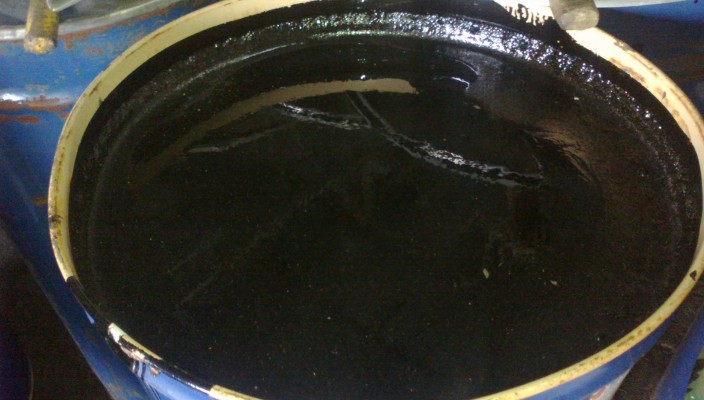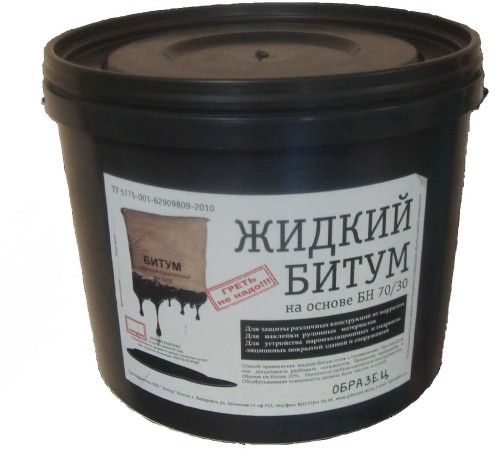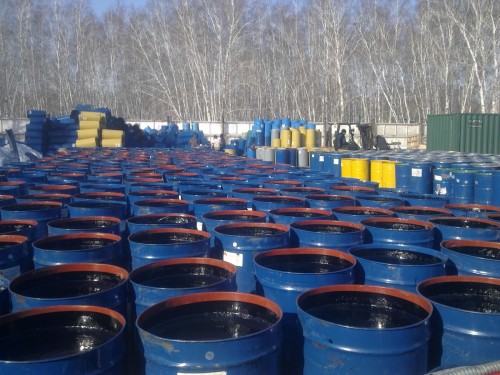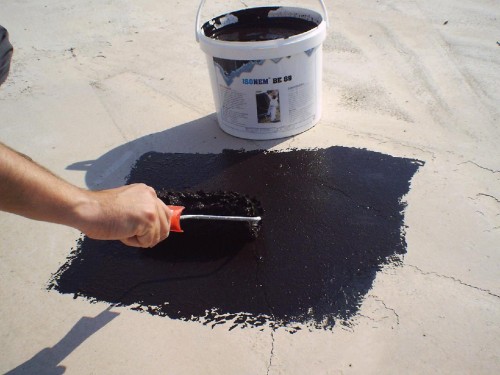Bitumen is used in almost all construction processes related to the construction of housing, industrial buildings and other objects. The properties of this product makes it possible to use it as an excellent water repellent. Accordingly, often liquid bitumen is used to increase the waterproofing of roofs of houses.
Content
Bitumen is made on the basis of the residues of some natural breeds. In particular, the bitumen includes coal, resin, oil, and peat.
If we talk about the properties of bitumen, then it is worth noting here that this material is viscous and plastic. With increasing temperature, the bitumen begins to soften, which allows it to use it for a number of construction work.
However, it should not be thought that in the summer period, bitumen will simply go into a liquid state and will become unsuitable for further use. To prepare the material, very high temperatures are needed, in which the liquid bitumen can immediately apply on the surface.
Liquid bitumen itself is quite unusual material, which has a number of features. It is about the main features of this product we will talk. We also mention the features of the use of bitumen in construction.
The main features of liquid bitumen
It is most important to note that the Bitumen itself is a viscous material, however, it is possible to increase its plasticity by heating. The liquid version of this product is sufficient to heat enough to make it suitable for use in construction work.
Moreover, liquid bitumen is a material that has the highest level of adhesion. It is that under certain conditions, it is "tightly" glued to the surface, and the submitted means of the layer of the frozen bitumen no longer delete. This speaks not only about the quality and reliability of the material, but also that any construction work related to the use of bitumen should be carried out as responsibly as possible.
Any bitumen products have some limitations. In particular, we are talking about a fragility temperature at which the material can easily damage and make it unsuitable for further use.
The process of thickening bitumen occurs in such a way that after applying the material to the surface, the oils present in the bitumen structure begin to evaporate. Thus, after a while after the start of this process, the material hardening occurs. The coating becomes insensitive to various deformations and other external influences.
Very often, liquid bitumen is used when creating a roadbed. The main advantage of this material is that it can be used in almost any conditions. Especially often make a choice in favor of a liquid bitumen in the winter, when the need to repair either a full masonry of the road canal appears. In such conditions, bitumen is a universal material.
However, it is possible to find bitumen with different structure on sale, so that individual varieties of this material are suitable for specific conditions that must be carefully analyzed.
Bitumen on the roof
Often, the owners use bitumen to increase the characteristics of the roof. Many people believe that this material has already outlived itself, but in fact everything is wrong. Liquid bitumen is actively used in cases where many analogues are charged to the owners too expensive. Yes, and in terms of efficiency, this construction resource is often not inferior to modern counterparts.
Considering that liquid bitumen is an inexpensive version for equipping a roof, you can not be afraid to damage it, and if necessary, you can easily re-apply the material to the surface.
Most often, a small trick is used to apply a bitumen on the roof. It consists in adding fuel to the material (motor, diesel). You can also use petroleum solvents. According to many experts, such solutions significantly increase the quality of the roof waterproofing created. It should be understood that often bitumen is not the main waterproofing layer. Most often, the above material serves just an intermediary between overlapping and impenetrable roofing material. In the event that the roof is damaged, the bitumen layer is able to easily reduce the destructive effect of moisture or even a large volume of water. In any case, it is hard to hope for the positive properties of liquid bitumen - not worth it.
In some situations, the hosts do not risk adding some modifiers to the bitumen. And it is precisely a big mistake. The essence is that in its natural state, bitumen has a number of problematic parties. The most serious problem can be the low strength of the created waterproofing layer. For example, after a large shower, bitumen can be very damaged. It is often obtained that under the action of high temperatures, the bitumen layer begins to rapidly crack. Obviously, it is impossible to use such waterproofing.
Accordingly, it makes sense to use various additives that increase not only the strength, but also the durability of liquid bitumen. The choice of certain additions to the bitumen composition depends only on the specific conditions in which the dwelling is.
Most often, liquid bitumen and rubberoid are used to create a roof. In parallel, various mastic can be used, which successfully confront the effect of high temperatures and atmospheric precipitation.
When complying with all technological subtleties, such a roof is able to serve without repair up to 10 years.
The most important thing in this process is to apply a qualitative bitumen to the desired surface areas. If there is not a bitumen at the junction between the roof strips is not to avoid problems. At the very beginning, perhaps nothing bad will happen, but a little later moisture will penetrate the room, and then the waterproofing material will begin to deform and crack.
If errors when creating a roof are detected immediately after the main process, it is necessary to fix them immediately. With a high probability of future there should be no problem.
Foundation and liquid bitumen
As already mentioned, bitumen is a universal material that is often used for the waterproofing of the foundation.
A little earlier it said that it is not recommended to use "clean" bitumen. However, in most cases it concerns the creation of a high-quality roof. For the waterproofing of the foundation, the classic bitumen is completely coming, the properties of which are suitable for confrontation of moisture.
The foundation waterproofing begins with the application of bitumen on the outer walls of the base. Already on top of the created layer it is necessary to impose a bitumen fabric made on the basis of rubber. Each millimeter of the canvas should come into contact with the foundation. It is also impossible to allow any slots and gaps between parts of the overhead material.
In the event that the basement is applied to the foundation, it is worth paying attention to the use of an exclusively single bitumen coating layer. With high probability, such a solution will avoid the negative impact of moisture and water.
Bitumen and asphalt coatings
In most cases, bitumen is used when creating asphalt coatings. Obviously, in this case there is a need to use an exceptionally high-quality bitumen, which for decades will maintain its initial properties. However, do not forget that insufficient strength and low durability are the main disadvantages of liquid bitumen.
Thus, in a number of cases, it is necessary to carefully monitor the state of roads created using bitumen. In the summer, this material is actively melting, and if overall vehicles move on the roads, the bitumen is gradually erased. It is for this reason that the movement of trucks during the daytime of the day is prohibited on some tracks. However, in the winter period there are also some restrictions. Often they are associated with the fragility of bitumens at low temperature indicators.
To improve the situation slightly, various plasticizers add to the asphalt. In addition, a solid bitumen is used, which is better interacting with asphalt coating.
The liquid bitumen is almost indispensable when repairing the road canvase. Most often we are talking about the fine repair of the latches, during which there are considerable volumes of liquid bitumen. Considering that this material is used on the upper layer of the roadway, there are special requirements for it.
The main features of the deposition of bitumen on the surface
Before using liquid bitumen, you need to be sure that the specific application technology is suitable for a specific situation. First of all, it is necessary to understand that this material is too picky, and any errors may have serious consequences.
At the very beginning, heating the bitumen mixture. Often, special installations are used for this, intended for smelting of individual construction resources. You can also melt bitumen in a conventional metal barrel, under which the fire is divorced. It is worth noting that during heating the bitum will begin greatly foam, but this should not be confused - this is a normal process. To make sure that bitumen is ready for use, it is enough to look at the surface of the mixture. If we see there a smooth and brilliant bitumen layer - the material can already be used in construction. It is worth understanding that overheating bitumen is also a very serious problem. If the material is too warm up, it is simply not recommended to use in construction. For example, if the bitumen, intended to cover the roof, was significantly overheated, after some time it will begin to crack, and then again will have to acquire bitumen.
To increase the characteristics of bitumen, various solvents are often used. It must be said in advance that the modification of the composition of bitumen is a fairly risky process that many troubles can bring. Despite this, it is worth knowing that diesel fuel is often addicted to the bitumen. For mixing, you need 2 times less solvent than bitumen. Bitume be heated separately from the solvent, and then mix. As for positive results from such experiments, the updated composition of the bitumen will be less sensitive to temperature drops. And this is a very important aspect, especially when using liquid bitumen as waterproofing.
As for directly applying bitumen to the surface, there are also some difficulties here. First of all, you need to know that bitumen is incredibly hard hard, so immediately after heating it is necessary to apply it to the surface. In this case, we have no more than three minutes. If the surface area on which the bitumen is applied is quite large, you can crush the material using a mop. In other cases, brushes and rollers are actively used.
If we talk about the used bitumen volumes, then they are as follows:
- to create waterproofing, up to 2 kg of bitumen per 1 m2 are used;
- during the construction of the road leaf, at least 2-3 kg of bitumen is 1 m2;
- for the asphalt impregnation, about 1 kg of material per 1 m2 will be needed.
Lifetime of bitumen coatings
In this material, many times mentioned that bitumen has a number of weak points, which, unfortunately, do not make a bitumen with a practical modern construction resource.
However, if you follow all the subtleties of the technology of applying bitumen to the surface, you can get a rather durable layer of waterproofing.
If we are talking about creating a protective layer for a roof, then often the service life in this case does not exceed 5 years. If the bitumen is used to increase the characteristics of the foundation, then the material will be here without any problems to serve for decades.
In other cases, it is necessary to update the bitumen layer every few years, since the material is rapidly losing its effectiveness.























